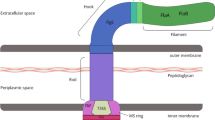Summary
The IgA and IgG antibody response to plasmid-encoded outer membrane proteins was studied in 59 patients with yersinia-associated spondylarthropathy during 15 months of follow-up. Initially, all patients had specific IgA and IgG antibodies to the 36 and 46 kDa and 30% also to the 26 and 58 kDa released proteins, which correlated with the finding of virulentYersinia bacilli in intestinal biopsies. IgA disappeared in 69% of untreated patients after nine months and persisted in 31% after one year. IgA disappeared within three to six months in 81% of the patients treated with antibiotics for four to six weeks and persisted in 6% after one year (p<0.002). IgG antibodies to the 36 and 46 kDa outer membrane proteins persisted in 80% of all patients. Disappearance of IgA was coupled with disappearance of yersinia from intestinal biopsies.
Zusammenfassung
Bei 59 Patienten mit Yersiniaassoziierter Spondylarthropathie wurde während 15 Monaten der Verlauf der IgA- und IgG-Antikörperantwort auf plasmidkodierte, äußere Membranproteine untersucht. Anfangs hatten alle Patienten spezifische IgA- und IgG-Antikörper gegen die 36 und 46 kDa und auch gegen die 26 und 58 kDa-Proteine, und dies korrelierte mit dem Nachweis virulenter Yersinien in Darmbiopsien. Bei 69% der unbehandelten Patienten war IgA nach neun Monaten verschwunden, bei 31% fand sich nach einem Jahr noch eine Persistenz. Bei Patienten, die vier bis sechs Wochen lang mit Antibiotika behandelt wurden, waren IgA- Antikörper innerhalb drei bis sechs Monaten in 81% der Fälle verschwunden; Persistenz nach einem Jahr war in 6% der Fälle nachzuweisen (p<0,002). IgG-Antikörper gegen die 36 und 46 kDa-Proteine persistierten bei 80% aller Patienten. Wenn IgA verschwand, war Yersinia auch nicht mehr in Darmbiopsien nachzuweisen.
Similar content being viewed by others
References
Heesemann, J., Keller, C., Morawa, R., Schmidt, N., Siemens, H. J., Laufs, R. Plasmids of human strains ofYersinia enterocolitica: molecular relatedness and possible importance for pathogenesis. J. Infect. Dis. 147 (1983) 107–115.
Heesemann, J., Gross, U., Schmidt, N., Laufs, R. Immunochemical analysis of plasmid-encoded proteins released by the enteropathogenicYersinia species grown in calcium-deficient media. Infect. Immun. 54 (1986) 561–567.
de Koning, J., Heesemann, J., Hoogkamp-Korstanje, J. A. A., Festen, J. J. M., Houtman, P. M., Van Oyen, P. L. M. Yersinia in intestinal biopsy specimens from patients with seronegative spondylarthropathy: correlation with specific serum IgA antibodies. J. Infect. Dis. 159 (1989) 109–112.
Stahlberg, T. H., Heesemann, J., Granfors, K., Tovainen, A. Immunoblot analysis of IgM, IgG and IgA responses to plasmid encoded released proteins ofYersinia enterocolitica in patients with or withoutYersinia triggered reactive arthritis. Ann. Rheum. Dis. 48 (1989) 577–581.
Granfors, K., Stahlberg, T. H., Isomaki, O., Tovainen, A. Specificity of IgA class anti-Yersinia antibodies inYersinia arthritis. Scand. J. Rheumatol. S67 (1988) 64–66.
Hoogkamp-Korstanje, J. A. A., De Koning, J., Heesemann, J. Persistence ofYersinia enterocolitica in man. Infection 16 (1988) 81–85.
Wauters, G., Kandolo, K., Janssens, M. Revised biogrouping system ofYersinia enterocolitica. Contrib. Microbiol. Immunol. 9 (1987) 14–21.
Bottone, E. J., Sheehan, D. J. Yersinia enterocolitica: guidelines for serologic diagnosis of human infections. Rev. Infect. Dis. 5 (1983) 898–906.
Blake, M. S., Johnston, K. H., Russell-Jones, G. H., Gotschlich, E. C. A rapid sensitive method of detection of alkaline phosphatase conjugated anti-antibody on westernblots. Anal. Biochem 136 (1984) 175–179.
Hoogkamp-Korstanje, J. A. A., De Koning, J., Samsom, J. P. Incidence of human infection withYersinia enterocolitica serotypes 03, 08 and 09 and the use of indirect immunofluorescence in diagnosis. J. Infect. Dis. 153 (1986) 138–141.
Mielants, H., Veys, E. M. HLA-B27 related arthritis and bowel inflammation. J. Rheumatol. 12 (1985) 287–293.
Heesemann, J., Schroder, J., Ulrich, M. Analysis of the class specific immune response toYersinia enterocolitica virulence-associated antigens in oro-gastrically infected rabbits. Microb. Pathog. 5 (1988) 437–447.
Keat, A. Reiter's syndrome and reactive arthritis in perspective. N. Engl. J. Med. 309 (1983) 1606–1615.
Heesemann, J., Eggers, Ch., Schroder, J., Laufs, R. Serological diagnosis of yersiniosis by the immunoblot technique using plasmid encoded antigens ofYersinia enterocolitica. In:Simon, C., Wilkinson, P. (eds.): Diagnosis of infectious diseases — new aspects. Schattauer, Stuttgart 1986, pp. 79–80.
Hoogkamp-Korstanje, J. A. A. Antibiotics inYersinia enterocolitica infections. J. Antimicrob. Chemother. 20 (1987) 123–131.
Larsen, J. H., Hartzen, S. H., Parm, M. The determination of specific IgA antibodies toYersinia enterocolitica and their role in enteric infections and their complications. APMIS [B]93 (1985) 331–339.
Toivanen, A., Lahesmaa-Rantala, R., Vuento, R., Granfors, K. Association of persisting IgA response withYersinia triggered reactive arthritis: a study on 104 patients. Ann. Rheum. Dis. 46 (1987) 898–901.
Ford, D. K. Reactive arthritis: a viewpoint rather than a review. Clin. Rheum. Dis. 12 (1986) 389–401.
Author information
Authors and Affiliations
Rights and permissions
About this article
Cite this article
Hoogkamp-Korstanje, J.A.A., de Koning, J., Heesemann, J. et al. Influence of antibiotics on IgA and IgG response and persistence ofYersinia enterocolitica in patients with yersinia-associated spondylarthropathy. Infection 20, 53–57 (1992). https://doi.org/10.1007/BF01711062
Received:
Accepted:
Issue Date:
DOI: https://doi.org/10.1007/BF01711062




